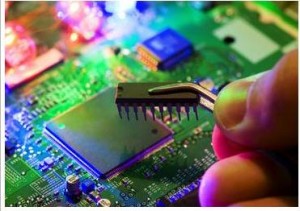Counterfeit electronic components aren’t just a problem for legitimate component makers. They’re also a huge problem for manufacturers of products who purchase bogus electronic parts, thinking that they’re the real thing. Counterfeit electronic parts are often of much lower quality than legitimate components, increasing the risk of malfunction or failure, thus compromising the quality of the devices and equipment in which they are used.
Electronic component procurement professionals need to be aware of the counterfeit electronic components problem and what is being done to stop it. Reducing the use of counterfeit electronic components can help companies avoid damage to their brand by product malfunctions and possible safety and legal liability costs.

A $100 Billion Problem
According to the Bureau of Industry and Security of the US Department of Commerce, counterfeit electronics cost the electronics industry about $100 billion each year. In the semiconductor segment alone, counterfeit electronics are a $7.5 billion problem. It is estimated that one in 10 of all electronic components are counterfeits.
The proliferation of bogus electronics has grown exponentially in recent years as globalization has made it easier for counterfeit makers – many of which are in Asia – to obtain specs, make bogus parts, and distribute them to countries with large markets for electronic components, such as the U.S. Electronic component procurement professionals have had to become increasingly vigilant to avoid bogus parts, but, even so, many still slip through testing and mitigation procedures.
The bogus electronics trade not only hurts the legitimate manufacturers of electronic parts, it also harms the end users of those parts. The problem is estimated to cost 11,000 U.S. jobs per year, both because of losses by the legitimate manufacturers, and by companies that use bogus parts in their devices or equipment.
Commonly Counterfeited Electronic Components
- Microprocessors
- Analog Integrated Circuits
- Transistors
- Tantalum Capacitors
- Programmable Logic Devices
- Memory Integrated Circuits
Electronic component procurement professionals need to be aware of the higher risk these parts offer and take steps to ensure that only legitimate parts are used in their products.
How Electronic Components Are Counterfeited
There are many ways to counterfeit electronic components, but one of the most common is a simple matter of dumpster diving. Counterfeiters will raid junkyards and electronic waste disposal sites for junked equipment, and remove the parts. The counterfeiters will then sand over the old markings or paint over them and apply new markings. Substituting parts with those of lesser quality is another common tactic, as is salvaging die-level electrical reject products and manufacturing new parts from these die.
Detection & Avoidance Strategies
The proliferation of bogus electronic parts in defense applications has become a grave concern for the U.S. government. A recent report found that as many as a million parts used by the military are counterfeit electronic components.
In 2011, Congress passed, and the president signed, the 2012 U.S. National Defense Authorization Act, which included regulations intended to help detect and avoid bogus parts in the defense industry. Suppliers at every level of the defense supply chain now have to take steps to curtail use of counterfeit electronic parts.
The new law makes contractors responsible for detecting and avoiding use of bogus parts, and also makes them responsible for performing work to remove these parts from defense applications. Defense contractors are no longer allowed to bill the government for the cost of reworking or corrective action taken to remedy the use of bogus parts. Also, the law requires the use of procedures and processes, to ensure that electronics are obtained from trusted and authorized suppliers.
The use of bogus electronics continues to be rampant in non-defense commercial applications, but companies are beginning to increase detection and avoidance of bogus electronic parts. Some avoidance strategies include:
- Using X-ray machines to check the restriction of use of hazardous substances status of parts. Bogus part manufacturers often neglect to follow standards restricting the use of hazardous materials in their components. Checking for these substances can help winnow out bogus parts.
- Decapsulation of random samples of parts can also help detect counterfeit parts. Manufacturers can use chemical decapsulation or mechanical decapsulation to verify manufacturers’ marks on the die-level product.
- Parametric testing involves comparing a sample part known to be authentic to samples of other parts to determine authenticity.
Companies using significant quantities of electronic components should institute a testing regime to ensure that they are using legitimate parts in their products. Defective bogus parts can result in a number of costs to companies that use them, such as harm to their professional reputation, refunds and chargebacks, and legal liability should injury result from a malfunctioning product. One of the easiest ways to reduce the risk of using counterfeit parts is to obtain them from a reputable electronic component procurement firm like Procure International Inc. Procure International works with OEM/CEMs to obtain quality, legitimate parts from manufacturers.
Sources:
http://www.ihs.com/info/sc/a/combating-counterfeits/index.aspx
http://www.integra-tech.com/counterfeit-detection.html
http://www.venkel.com/compliance/infographics/counterfeit-components-infographic






